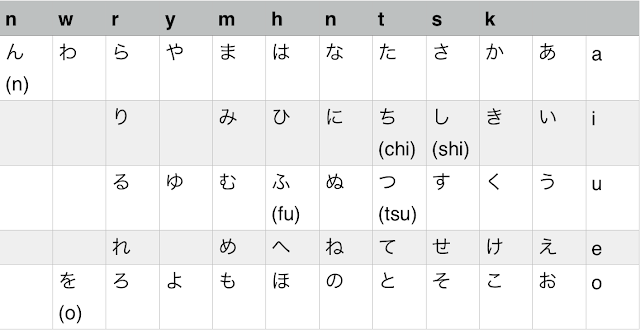Kana & Kanji
As you might know, the Japanese writing system is divided in three systems: Hiragana(ひらがな), Katakana(カタカナ) and Kanji(漢字). Hiragana and Katakana are known as Kana. The written out version of the Kana and Kanji is known as Rōmaji. Avoid using Rōmaji except for the beginning of your Japanese learning process because it is not accurate and Japanese people don't understand Rōmaji.
The Kana writing system is made up of phonetic syllables. The syllables are created by combining a consonant with the five vowels. For example, the “ka-series” is created by combining “k” with the five vowels. This results in “ka”, “ki”, “ku”, “ke”, “ko”.
For all the upcoming lessons I will be using either Hiragana or Katakana in the examples. I will provide the Rōmaji version below in case you are not interested in learning the Japanese writing system.
Hiragana(ひらがな)
The Hiragana system is the phonetic version of the language. The language uses these syllables to form and pronounce any word.
You will have to memorize these syllables. In order to do so, you have to write them out several times until you remember them completely.
I recommend you use a college block and then you write a whole line of "ka's" and then you move on to "ki","ku", "ke", "ko", ect.
example:
かかかかかかかかかかかかかかかかかか
As you can see, the wa-series series has only two syllables. The wo “を” is used exclusively as a particle in grammar. In the upcoming lessons, I will write more about particles and the syllable “を”.
The stroke order is important to make your writing more fluid and give the symbols the correct form. You start from the top left and work your way down to the bottom right. From left to right and from top to bottom.
When writing Japanese symbols, you have to imagine a square. All symbols have to fill that square.
The two small lines (quotation mark like) are called dakuten(濁点).
When you add dakuten to the ka-series, these syllables become “ga”, “gi”, “gu”, “ge”, “go”.
When you add dakuten(濁点) to the sa-series, these syllables become “za”, “ji”, “zu”, “ze”, “zo”.
When you add dakuten(濁点) to the ta-series, these syllables become “da”, “ji”, “dzu”, “de”, “do”.
When you add dakuten(濁点) to the ha-series, these syllables become “ba”, “bi”, “bu”, “be”, “bo”.
The small circle on the upper right corner is called handakuten(半濁点). When you add handakuten(半濁点) to the ha-series, these syllables become “pa”, “pi”, “pu”, “pe”, “po”.
Special Rules
Now that we know all the syllables, we will introduce some special rules.
Double consonant
In order to double a consonant, we have to use a small “tsu(つ)”.
The consonant that comes after the small tsu(つ) is doubled.
There is an exception to this rule. If you want to double the consonant “n”, you don’t use the small tsu(つ). In this case, you use the lone “n(ん)”.
どんな
donna
Combined syllable
You can combine the syllables that end in “i” with a small “ya”, “yu”, “yo” to form a combined syllable.
You can attach the small characters of ya, yu, yo to the characters of ki, gi, shi, ji, chi, ni, hi, bi, pi, mi and ri.
Once you finish this, you are done with Hiragana(ひらがな). You have all the rules you need to become a master in reading and writing it. If you want to improve your new skill, you can go and search the web for some child books in Hiragana(ひらがな). A nice title to start with is "Saru kani Gassen"(さるかにがっせん). You won't be able to understand what you read just yet but you will be able to read it.
The links below contain valuable legal websites with Hiragana(ひらがな) texts, stories and fairy tales. Some of these websites offer even a translation and some vocabulary of the text.
- http://hukumusume.com/douwa/betu/jap/05/01.htm
- http://hukumusume.com/douwa/betu/yuumei_01.html
- http://life.ou.edu/stories/
- http://www.asagaku.com/index.html
If want you to download legal free Japanese literature you can visit Aozora Bunko. This site offers free books of authors that died 100 years ago. You can download those books in different formats. You can work your way through the entire website with google translate and find all sorts of books. The books have some Kanji but they have furigana(small hiragana symbols) on top so you can read the Kanjis without knowing them.
My favorite book is a classic of japanese child literature. It was written by Kenji Miyazawa and is called "Night on the Galactic Railroad". You can find it here:
DOWNLOAD EBOOK
Try to improve your reading speed and getting used to reading Hiragana(ひらがな).
In the coming lessons, we will introduce you to katakana(カタカナ) and some vocabulary(ごい) so you can start understanding the basics.
In the coming lessons, we will introduce you to katakana(カタカナ) and some vocabulary(ごい) so you can start understanding the basics.



